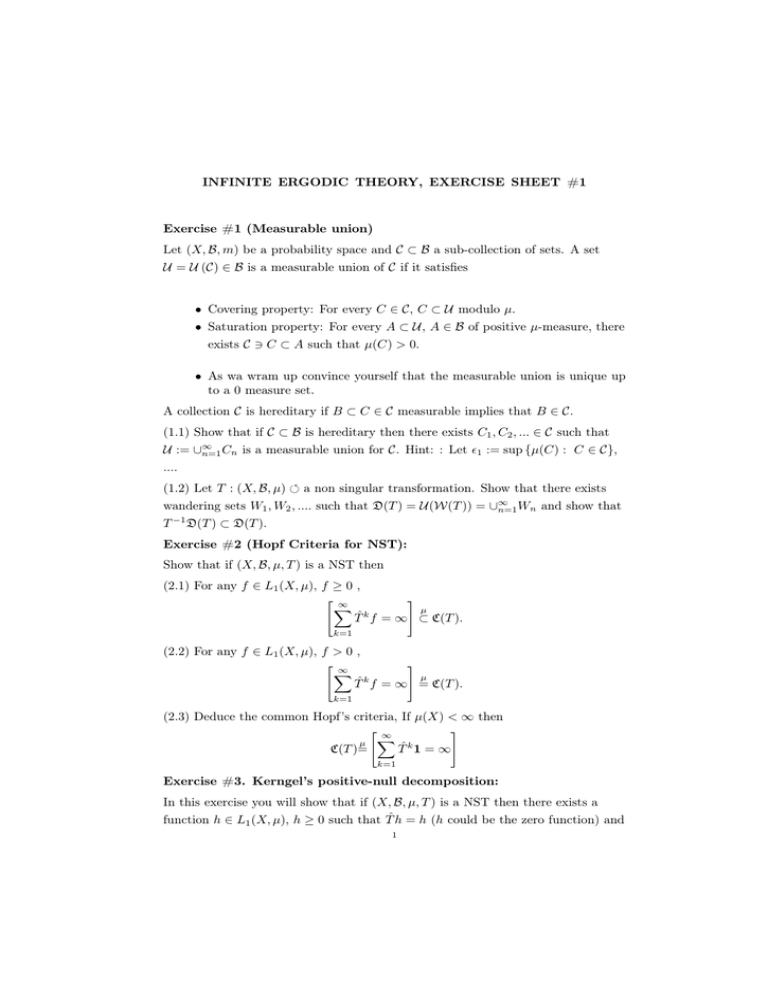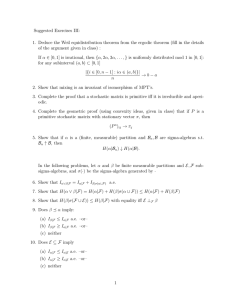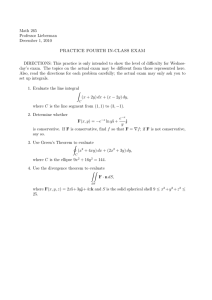INFINITE ERGODIC THEORY, EXERCISE SHEET #1 Exercise #1 (Measurable union)
advertisement

INFINITE ERGODIC THEORY, EXERCISE SHEET #1
Exercise #1 (Measurable union)
Let (X, B, m) be a probability space and C ⊂ B a sub-collection of sets. A set
U = U (C) ∈ B is a measurable union of C if it satisfies
• Covering property: For every C ∈ C, C ⊂ U modulo µ.
• Saturation property: For every A ⊂ U, A ∈ B of positive µ-measure, there
exists C 3 C ⊂ A such that µ(C) > 0.
• As wa wram up convince yourself that the measurable union is unique up
to a 0 measure set.
A collection C is hereditary if B ⊂ C ∈ C measurable implies that B ∈ C.
(1.1) Show that if C ⊂ B is hereditary then there exists C1 , C2 , ... ∈ C such that
U := ∪∞
n=1 Cn is a measurable union for C. Hint: : Let 1 := sup {µ(C) : C ∈ C},
....
(1.2) Let T : (X, B, µ) a non singular transformation. Show that there exists
wandering sets W1 , W2 , .... such that D(T ) = U(W(T )) = ∪∞
n=1 Wn and show that
T −1 D(T ) ⊂ D(T ).
Exercise #2 (Hopf Criteria for NST):
Show that if (X, B, µ, T ) is a NST then
(2.1) For any f ∈ L1 (X, µ), f ≥ 0 ,
#
"∞
X
µ
k
T̂ f = ∞ ⊂ C(T ).
k=1
(2.2) For any f ∈ L1 (X, µ), f > 0 ,
"∞
#
X
µ
k
T̂ f = ∞ = C(T ).
k=1
(2.3) Deduce the common Hopf’s criteria, If µ(X) < ∞ then
"∞
#
µ X k
C(T )=
T̂ 1 = ∞
k=1
Exercise #3. Kerngel’s positive-null decomposition:
In this exercise you will show that if (X, B, µ, T ) is a NST then there exists a
function h ∈ L1 (X, µ), h ≥ 0 such that T̂ h = h (h could be the zero function) and
1
INFINITE ERGODIC THEORY, EXERCISE SHEET #1
2
for any f ∈ L1 (X, µ)
Ân f =
n−1
1X k µ
T̂ f −
→ 0 on [h = 0] .
n
k=0
´
´
Here T̂ is the transfer operator with respect to µ ( Tˆf gdµ = f g ◦ T dµ). The
set N ull(T ) := [h = 0] is T -invariant and there exists no µ- absolutely continuous
invariant probability on N ull(T ).
(3.1) Show that Ân f −−−−→ 0 a.e. on D(T ) so we can assume WLOG that T is
n→∞
conservative.
(3.2) Let
n
o
P := A ∈ B : ∃h ∈ L1 (X, µ), h ≥ 0, T̂ h = h, A ⊂ [h > 0] .
Show that P is hereditary. If P consists only of negligible sets there is no
absolutely continuous invariant measure.
(3.3) Deduce that there exists hn ∈ L1 , hn ≥ 0,
´
hn dµ = 1, T̂ hn = hn and
∪∞
n=1 Bn
Bn ∈ P such that Bn ⊂ [hn > 0] and
= U (P).
P −n
(3.4) Show that setting h = n 2 hn then U(P) = [h > 0] and that for every
H ∈ L1 (X, µ), H ≥ 0, if T̂ H = H then U(P)c ⊂ [H = 0].
(3.5) Deduce the result using Krengel’s stochastic ergodic Theorem.
Exercise #4 (Inner functions)
Let T : (R, m = Leb) → (R, m) be defined by
T x = αx + β +
N
X
k=1
pk
tk − x
with α, p1 , .., pn > 0 and β, t1 , ..., tn ∈ R. Recall Boole’s formula which states that
T is non singular and for w = a + ib ∈ C, the functions
1
b
= Im
ϕw (x) =
(x − a)2 + b2
x−w
satisfy T̂ ϕw = ϕT w .
(4.1.1) Show that T is conservative iff for some (hence for all) w ∈ C with
Im(w) > 0,
∞
X
ϕT n w (x) = ∞ for a.e. x ∈ R
k=0
(4.1.2) Show that T is conservative iff for some (hence for all) w ∈ C with
Im(w) > 0,
∞
X
−1
Im
= ∞.
T n (w)
k=0
INFINITE ERGODIC THEORY, EXERCISE SHEET #1
(4.2) Show that m ◦ T −1 =
1
αm
3
by
• Show that bϕib −−−→ 1 uniformly on compact subsets. Hence for any
b→∞
N
A = [a, b] ⊂ R such that {tk }k=1 ∩ T −1 A = ∅,
ˆ
ˆ
1A ◦ T dx = lim
bϕib 1A ◦ T dx
b→∞
R
R
• Show that if T (ib) = u(b) + iv(b) with u, v : R → Rthen
u(b)
−−→
b −
b→∞
v(b)
−−→
b −
b→∞
α and
0.
• Deduce using Boole’s formula and the previous step that bT̂ ϕib −−−→
b→∞
1
α
uniformly on compact subsets and conclude the Theorem.
(4.3) Show that if α > 1 then T is dissipative.
Exercise #5: (Dissipative Bernoulli shifts and the Gurevic’-Oseledec
Theorem).
Let X = {0, 1}Z and T : X → X be the full shift (T x)i = xi+1 . For p 6= q,
p, q ∈ (0, 1) define a product measure on X by
n
Y
Pj (aj )
µ ([a]nk ) =
j=k
where
(5.1) Calculate
(
p, k ≥ 0,
Pk (0) = 1 − Pk (1) =
.
q, k < 0
dµ◦T −1
dµ
µ
and T̂ n 1. Use this to show that (X, B, µ, T ) is totally
dissipative (D(T ) = X).
(5.2) Give another proof that the shift is dissipative by showing that ∀ > 0
there exists a set A ∈ B with µ (A ) > 1 − and
∞
X
1A ◦ T k < ∞, a.e x ∈ A .
k=1
Hint: Think about what does the weak (or strong) law of large numbers say about
P−1
P−1
1
1
N
k=n xk versus n
k=n T x k for N > n large.
n
Remark: The Gurevic’ Oseledec theorem says that a C 2 conservative hyperbolic
transformation of a manifold has always a volume absolutely continuous invariant
probability measure. Its proof is similar to (5.2) with use of the Markov partitions
and existence of equilibrium measures developed by Sinai.




